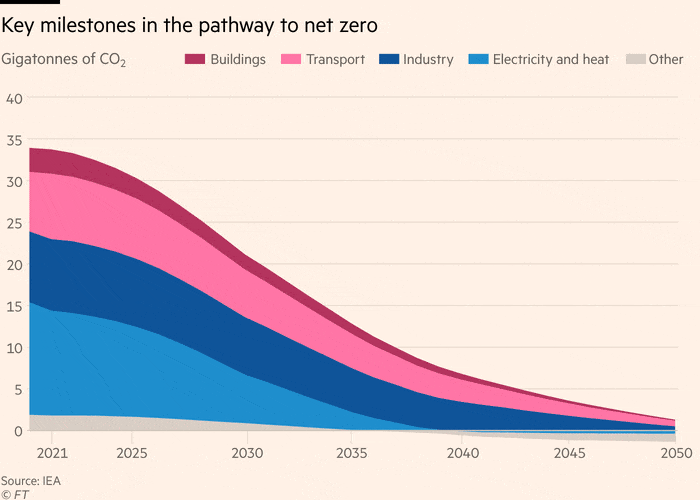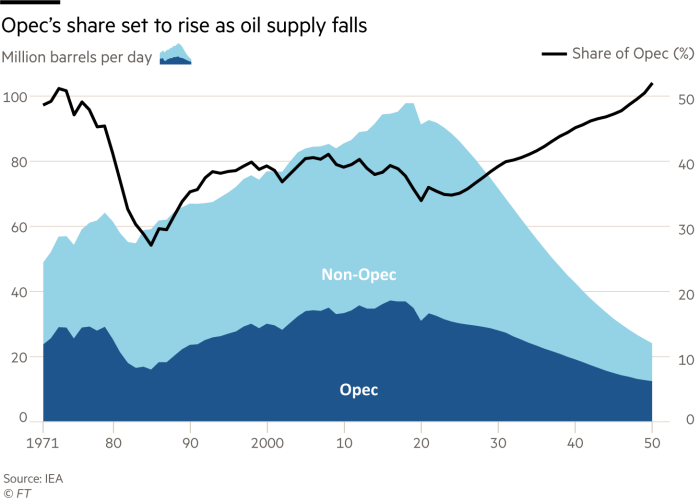How can the world get to net zero emissions by 2050?

Simply sign up to the Climate change myFT Digest -- delivered directly to your inbox.
What is the best way to reach net zero emissions by 2050? The International Energy Agency, a Paris-based oil watchdog, has mapped out a pathway that it says is “narrow but still achievable” if the world is to cut carbon dioxide emissions to nearly zero and limit global warming to 1.5C.
Meeting this goal, which has been adopted by major economies such as the EU, US and UK, would require a total transformation of the global economy over the next three decades.
Under the IEA’s scenario, this would include ending the sale of conventional petrol cars by 2035, reaching 100 per cent clean energy by 2040 and using heat pumps to meet at least half of all heating needs by 2045.
While some industry executives and major energy consuming countries have deemed the pathway out of touch with the reality of current consumption patterns, it showcases the sheer overhaul of the energy system that would be required.
Total energy consumption in 2050 would be less than it is today because of improvements in efficiency, even though the global economy will be 40 per cent larger than it is now.

Most of the energy would come from renewable sources, with the IEA forecasting that solar power will increase 20 times and wind power 11 times by 2050. Electricity use would also grow. Today, about 20 per cent of total energy consumption is electric. By 2050, this would rise to 50 per cent in this scenario.

A corresponding spending boost in electricity infrastructure would be required. Total capital investment in the energy sector would need to rise to $5tn a year, of which investment in transmission and distribution grids would rise to $820bn annually in 2030 from $260bn today.
Fossil fuels such as coal, oil and gas would have a very limited role by 2050 in this scenario. Coal would decline to just 4 per cent of the global energy supply, mostly from power plants that are equipped to capture carbon dioxide before it is released.

Oil and gas would play a slightly larger role in 2050, but not by much, according to the IEA. Oil demand would fall by 75 per cent, reaching 24m barrels per day and gas demand would decline by 55 per cent under the agency’s scenario.
The IEA report says no new exploration for oil, gas or coal supplies would be necessary, as producers would be focusing only on their existing assets. Notably, this means that the Middle East would produce a growing share of the world’s oil supplies over time. As a result, Opec’s control of the oil market would grow to about 52 per cent, its highest level ever.
The IEA was founded in 1974 by oil-consuming OECD countries, which were concerned about access to supplies after the Arab oil embargo that sent prices surging. Its mandate has subsequently evolved to consider all forms of energy security.

The IEA report is clear that none of this will happen without major policy changes and a surge in energy investment. People will have to change their lifestyles, it says, with about 4 per cent of the forecast emissions reductions to come from changes in behaviour, such as taking fewer long-haul flights.
Policymakers will also have to use every tool at their disposal, including placing a price on carbon dioxide emissions. As the price of oil declines in the net zero scenario, the price of carbon dioxide will rise, the IEA forecasts, particularly in developed countries.
Governments will also need to accelerate their plans to cut emissions. Existing government climate plans, which were also examined by the IEA in this report, will only cut emissions by 35 per cent by 2050.

Follow @ftclimate on Instagram
Letter in response to this article:
Commission state aid rules ignore net zero pathway / From Jutta Paulus, Member of the European Parliament, Greens/European Free Alliance Group, Brussels, Belgium
Comments